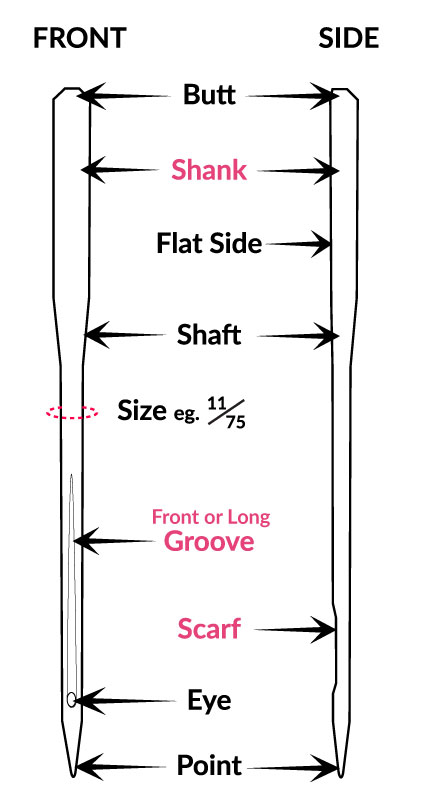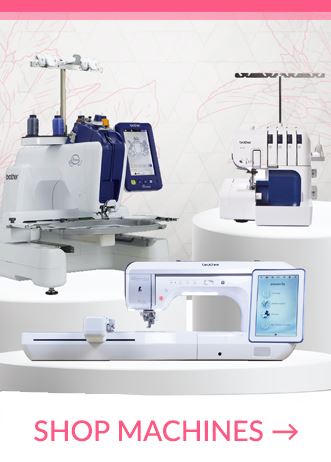Which needle should you be using?
Date Posted:28 February 2022
Each needle type is specifically designed to penetrate a certain fabric. Changing needles was not so necessary in the days when fabrics were only made of natural fibres. Today, modern fabrics like stretch knits, synthetics, etc. are used every day. However, when using these fabrics, changing the needle to match the type of fabric is important to gain the best stitch quality.
All domestic sewing machine needles are "flat-backed," meaning they have one rounded side and one flat side on the top part (the shank). This design ensures you can only insert the needle into your machine in one correct position. Overlocker needles are also "flat-backed," but their specific shape may vary.

Anatomy of a needle
Shank: The section of the needle that is inserted into the machine. Round side to the front. Flat section to the back.
Shaft: The body of the needle. Its diameter determines the needle size.
Groove: The thread lies in the groove as the needle shaft penetrates the fabric. It protects the thread as it passes through.
Scarf: The indentation or cutout on the back of the needle, just above the eye. The scarf creates space for the bobbin hook to grab the thread loop, which is essential for forming a secure stitch.
Eye: The hole at the bottom of the needle through which the thread is passed. The eye size is matched to the thread and needle size.
Point: The very tip of the needle, which comes in different shapes to handle various fabrics.
Size: Indicates the diameter of the needle blade often shown as 2 values (European/American).
Needle point shapes

Needle Size Scale
Needle size is based on the diameter of the needle's shaft. Domestic sewing needles have a dual-number sizing system that combines two scales: one European and one American. The numbers on the package will look something like 80/12 or 90/14.
| Size Range | European (Metric) | American (Singer) | Fabric Weight |
|---|---|---|---|
| Very Fine | 60-70 | 8-10 | Silks, chiffon, fine lace |
| Lightweight | 70-80 | 10-12 | Cotton, quilting cotton, linen |
| Medium-Weight | 80-90 | 12-14 | Denim, poplin, twill |
| Heavy-Duty | 90-110 | 14-18 | Canvas, upholstery, multiple layers |
Demystifying the Number: The European (or Metric) number is the needle's diameter in millimeters, multiplied by 100. For example, a size 80/12 needle has a shaft diameter of 0.8mm. Similarly, a 90/14 needle has a diameter of 0.9mm.
Needle TypeUsing the incorrect type of needle can cause skipped stitches and produce poor quality stitching. Many sewing problems can be avoided by regularly changing your needle and selecting the correct needle for the job. Below is a list of the basic machine needles and a guideline of which fabric is best suited to the needle type. |
|---|
|
Embroidery Needles (EBBR) All fabric types. The suffix EBBR stands for Embroidery, Ballpoint, Beaded-eye, Reinforced |
|
Large Eyelet Embroidery Needles For use with glow in the dark threads. If you are experiencing issues when using a standard embroidery needle with metallic threads, we suggest trying this needle. |
|
Chiffon, Georgette, Fine Lace, Organdy Net, Tulle, Batiste, Voile, Lawn, Gingham, Muslin, Poplin, Gabardine, Broadcloth, Linen, Velvet, Fake Fur, Wool, Curtain Fabrics. The H suffix is a basic marker for a flat-shank, universal needle. |
|
Ballpoint/Jersey Needles (SUK, SES, SP) Jersey - Wool, Cotton & Synthetic. The suffixes SUK, SES, and SP all signify a ballpoint needle. |
|
|
|
Tricot, Lingerie Fabrics, Interlock, Double Knit, Fleecy, Lycra, Spandex. |
|
For use with a quilt sandwich consisting of usually three layers: |
|
Denim, Sailcloth, Canvas, Shadecloth, Corduroy. Marked by a designated suffix H-J. |
|
Leather, Suede, Vinyl, Rubber Backed Curtains. Marked by a designated suffix H-LL. |
Other Speciality Needles |
|---|
|
Overlocker Needles All fabrics (finer fabrics use a finer needle) |
|
Topstitch Needles Has an extra-large eye and deeper groove for use with heavier topstitching or decorative threads. |
|
Hemstitch or Wing Needles Are designed for decorative stitching on tightly woven fabrics. Wide wing blades or fins on each side of the shank create openings in tightly woven fabric such as linen and batiste fabric to resemble entredeux trim. |
|
Twin Needles Are generally used for topstitching on garments. Two needles are put on a single crossbar to create perfectly parallel, multiple rows of stitching in one pass using a single bobbin thread. |
Overlocker Needles
While your sewing machine and overlocker may look similar, they use different types of needles. Most domestic overlockers require a specific type of needle known as the ELx705.
Why is it different? The ELx705 has a longer, reinforced blade and a second long groove. This unique design is essential for the high speeds of an overlocker and prevents bending while handling the machine's loopers and threads.
Default Point The ELx705 is typically a ballpoint needle, making it suitable for knit fabrics, which are the most common overlocker projects.
When to change your needle
- Listen for clicking or thumping sounds—this often indicates a dull or damaged needle.
- A worn needle can cause poor results, machine damage, or even breakage, posing a safety risk.
- Needle lifespan varies—it might last anywhere from 5 minutes to 5 hours depending on the fabric.
- If you notice skipped stitches or thread breakage, replace the needle immediately.
- As a general rule, change the needle every 8 hours of continuous sewing.





